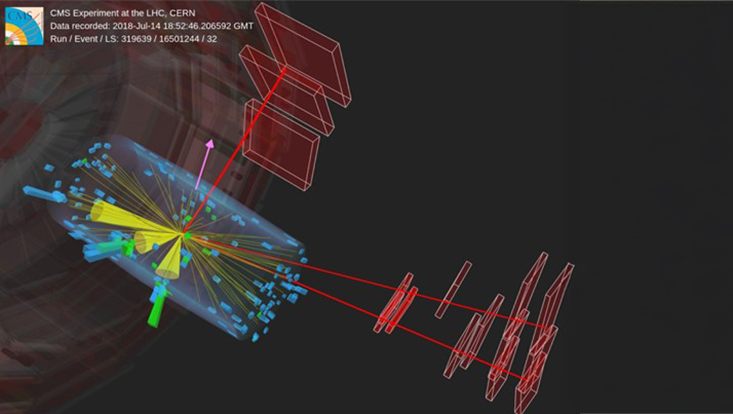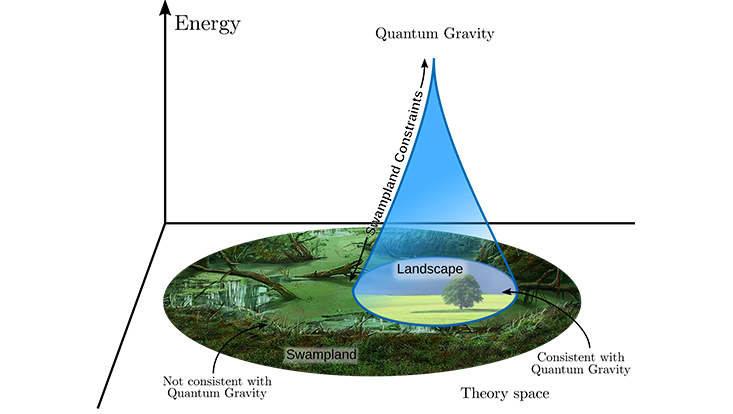Electromagnetic Flashes from fast Ejecta in Neutron Star Collisions
4 April 2025
![Supercomputer simulation of the collision of two neutron stars with 1.2 and 1.6 times the mass of our Sun. Simulation from [1].](https://assets.rrz.uni-hamburg.de/instance_assets/fakmin/40763851/neutron-star-ejecta-rosswog-089610a524303d17945acd9c729506edfba719d1.webp)
Photo: Rosswog et al. (2025)
In a recent study lead by Quantum Universe principal investigator Prof. Stephan Rosswog from the Observatory of the University of Hamburg, scientists applied their newly developed methodology in Numerical Relativity to identify how collisions of neutron stars eject small amounts of matter at velocities close to the speed of light. This high-velocity matter produces electromagnetic flashes that carry telltale information about the physics of such violent collisions. These flashes are prime science goals of the Israeli-German satellite ULTRASAT, to be launched in 2027.
Like humans, stars evolve: they are born in the collapse of cosmic gas clouds, they subsequently evolve due to nuclear burning processes in their interiors and – once their nuclear fuel has run out after millions of years – they die. The most massive stars end their lives as spectacular explosions called "supernovae" and these leave behind either black holes or neutron stars.
Neutron stars are extreme in every respect. They are – despite their large masses of about 1.5 times the mass of our Sun – only about 10 km in radius and this combination of large mass and small size produces gigantic gravitational fields. Therefore, the spacetime around a neutron star is nearly as extremely curved as around a black hole. In addition, this mass-size combination also means that the matter inside a neutron star is many times denser than in the nucleus of an atom, which makes them the densest form of matter in the Universe.
Many thousand neutron stars have been observed to date, and a few of them revolve around a companion neutron star. Such double neutron star systems are very precious laboratories for physics under the most extreme conditions: they allow for very precise measurements of neutron star masses, they enable us to probe how the densest form of matter behaves and their orbital motion can be used to probe Einstein's General Theory of Relativity. The first such double neutron star system was detected in 1974 and this system proved, after more than half a century of doubt, that Gravitational Waves really do exist. This confirmation provided a lot of momentum to the efforts to detect gravitational waves from neutron star binaries directly with terrestrial laboratories. This goal was finally achieved in 2017: the LIGO-Virgo collaboration detected the gravitational waves from an inspiraling neutron star binary and, shortly after the collision, telescopes all around the world could observe a firework of radiation all across the electromagnetic spectrum.
Much about physics can be learned from such neutron star collisions: apart from testing Einstein's General Theory of Relativity, the first observation of colliding neutron stars also confirmed that such collisions forge and eject many of the heaviest elements in the Universe (elements such as gold and platinum), thereby confirming Rosswog's earlier theoretical predictions. While matter is ejected into space with average velocities of about twenty percent of the speed of light, a small fraction of matter reaches more than seventy percent of the speed of light. Since this matter expands fastest, its electromagnetic radiation can escape first. The Israeli-German ULTRASAT satellite, for which DESY is building hardware, will be launched in 2027 and this mission aims to detect such early electromagnetic flashes following shortly after the gravitational wave signal of a neutron star collision. These signals carry information about the parameters of the merged binary system (e.g. the ratio of the two neutron star masses), but also about the properties of densest matter states in the Universe. Therefore, the understanding of these electromagnetic signals directly following a neutron star collision is of fundamental importance.
Several research groups that perform Numerical Relativity simulations of neutron star collisions had seen such fast ejecta. However, with conventional Numerical Relativity methods it is non-trivial to figure out how these small amounts of fast matter are actually launched. Stephan Rosswog (Observatory University of Hamburg), together with close collaborator Peter Diener (Louisiana State University, USA) has recently developed a new methodology to solve the general relativistic fluid dynamics equations in a different way. With their new Numerical Relativity methodology, they were able to identify two different mechanisms by which fast matter is flung out into space. Based on these findings, the research team, also including Nikhil Sarin (Stockholm) and Ehud Nakar (Tel Aviv), made detailed predictions for the electromagnetic emission coming from such fast ejecta which will help satellites such as ULTRASAT to detect them.


